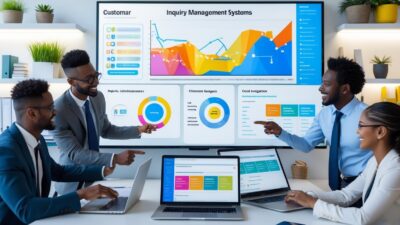B2B opportunity hunting is all about spotting and creating new business that actually fuels growth. You win by finding the right prospects, reaching out with intent, and turning interest into something that lasts.
This isn’t a game of luck. I build a system to spot openings in the market and act before anyone else does.

I like opportunity hunting because it keeps my pipeline full and revenue steady. Instead of sitting back and hoping for leads, I research markets, qualify prospects, and talk to decision-makers in ways that actually matter to them.
This approach helps me close deals and build relationships that keep paying off.
Key Takeaways
- Opportunity hunting means you go after new business, not just wait for it.
- Skills, habits, and steady activity are what make it work.
- Growth comes from mixing new opportunities with strong relationships.
Understanding B2B Opportunity Hunting
I pay close attention to finding the right prospects, knowing how sales roles split up, and why going after new opportunities really drives growth in B2B sales. It’s about knowing when to chase new business and when to look after your current clients.
What Is B2B Opportunity Hunting?
B2B opportunity hunting is just me looking for and chasing new business prospects that fit what my company really wants. Unlike leads that come to you, these chances usually need me to dig into industries, watch market trends, and reach out directly to decision-makers.
I look for signals—maybe a company’s growing, just got funding, or there’s a new regulation that creates a need. Like, if a construction firm’s expanding, they might need new tech or equipment.
I use prospecting methods that are structured. CRM tools, LinkedIn, intent data platforms—all help me track activity and spot buyers.
By focusing on opportunities, not just scattered leads, I can talk to whole buying groups, like in opportunity-based marketing.
That way, I’m not just chasing random people. I’m aiming at prospects who are way more likely to convert.
The Hunter vs. Farmer Mentality
In B2B, hunters and farmers do different things but both matter. Hunters go after new business. Farmers keep existing accounts happy and growing.
As a hunter, I’m all about prospecting, cold outreach, and starting relationships from scratch. I look at how many good opportunities I bring in. It’s a lot of persistence and sometimes you just have to deal with rejection.
Farmers are great at managing accounts, finding chances to upsell, and making sure clients stick around. The hunter-farmer model in B2B sales helps teams balance new growth with stability.
When hunters and farmers work together, companies can grow and keep clients loyal.
Importance of Opportunity Hunting in B2B Sales
Opportunity hunting is huge for revenue growth. If I only lean on current accounts, I end up stuck.
New opportunities keep my pipeline healthy. They stop me from depending on just a few customers.
In B2B, buying decisions involve lots of people. Hunting lets me find and talk to these groups early, which gives me a real edge.
When the market changes—maybe tech shifts or new rules come in—new chances pop up. By staying proactive, I can match my solutions to what customers need right now.
If you’re tired of chasing all this yourself, honestly, it’s easier to get quality leads from someone who already does the hard work. Feel free to contact me on Whatsapp if you need consultation or want to buy leads: +917303556188. Why stress when you can just get the right leads delivered?
Key Skills and Traits of Effective Sales Hunters
Let’s talk about what makes a good sales hunter. You need to reach new people, handle setbacks, and keep moving.
Strong selling skills, resilience, and discipline shape how I work in tough B2B environments.
Essential Selling Skills for Hunters
I stick to clear, real-world selling skills. Active listening is huge. I ask questions and actually listen, so I can figure out what people really need.
I use progressive qualification too. No need to cram every question into one call. I spread them out, confirm fit, and avoid wasting time on bad leads.
Persistence is everything. I don’t just give up after one “no.” Like top sales hunters, I keep things respectful and keep the conversation alive until it’s clear if there’s a real chance or not.
I also use LinkedIn to research, connect, and build credibility. These skills help me turn cold outreach into real opportunities.
Resilience and Adaptability
I deal with rejection and uncertainty all the time. Cold calls end fast, but the next one could be gold.
Markets move, industries change, buyers want new things. I adjust my outreach and messaging to stay current. Sometimes, I switch from email to video if that gets more attention.
You never really know if a chat will be quick or go deep. I stay flexible to match what the prospect wants.
Self-Motivation and Discipline
I don’t wait for leads to show up. I make my own plan, set personal goals, and track how I’m doing.
Discipline keeps me on track. I block out time every day for prospecting—no excuses.
Self-motivation keeps me improving. I test new ideas, tweak my approach, and always look for better ways. That’s what separates the hunters who just scrape by from the ones who crush quota.
Core Activities in B2B Opportunity Hunting

I stick to a sales process that helps me find, reach, and nurture accounts. That means using structured prospecting, smart outreach, and steady follow-up.
Prospecting Techniques
I always start with my ideal customer profile (ICP). That helps me avoid wasting time on accounts that won’t convert.
I use LinkedIn and CRM tools to map out who’s who in a company. Knowing the decision-makers makes my approach way more targeted.
I mix inbound and outbound. Account-based marketing targets the big fish, but I also love referrals—they convert better. B2B prospecting shows referrals are usually warmer than cold outreach.
I watch for signals—website visits, webinar signups, content downloads. These tell me who’s actually interested.
Cold Calling Strategies
Cold calling still works if you prep right. I always look up the company and contact before dialing. That way, I can mention real pain points or recent news.
I keep my opener short. My goal? Get interest and book a meeting—not dump info.
Best practices:
- Use intent data to call people already looking for solutions
- Ask open-ended questions to dig into challenges
- Match tone and pace to the person on the other end
Modern cold calling is still one of the best ways to reach execs—if you do your homework.
Follow-Up Best Practices
I never count on just one email or call. I plan a sequence—emails, LinkedIn messages, calls.
Every follow-up adds something useful. Maybe I send a case study, a quick insight, or a demo clip. I want prospects to see I get their needs, not just that I want a sale.
Timing matters. A follow-up within 24–48 hours works best. Wait too long and they forget you.
I use CRM reminders and templates to stay on top of things. Consistent follow-up, like opportunity-based marketing suggests, is what turns interest into real business.
Building Relationships for Long-Term Success

I want to build trust, use the right channels, and balance chasing new business with keeping clients happy. That’s how I keep clients loyal and results strong.
Establishing Trust with Prospects
Trust comes from understanding what a client really wants. I ask questions and listen, instead of just pushing my product.
I stick to my word—quick responses, honest updates, clear timelines. When I deliver on the small stuff, clients start trusting me with the big stuff.
Sharing case studies or success stories helps too. It shows I’ve solved similar problems before.
Networking and Social Selling
I use networking and social media to reach more decision-makers. LinkedIn is gold for B2B—I can research, engage, and start conversations in a way that feels natural.
Instead of spamming pitches, I build visibility. Posting insights, commenting on industry updates, and sharing useful articles keeps me on people’s radar.
I also go to events and webinars. Meeting people both online and in person makes my network stronger.
Balancing Hunting and Relationship Management
I don’t just chase new business and ignore my clients. Hunting brings in new deals, but managing relationships keeps revenue steady.
I block time each week for both prospecting and client check-ins. That way, I’m always moving forward with new leads and keeping current clients happy.
Regular feedback helps me spot small issues before they become big ones. That’s how I keep clients loyal and my pipeline full.
If you’d rather skip the grind and just get great leads, reach out on Whatsapp: +917303556188. Seriously, why work so hard when you can let someone else do the heavy lifting? Feel free to contact me for consultation or to buy leads—I’m here to help.
Measuring and Optimizing the Opportunity Hunting Process

I track my results to see what’s working. By watching the numbers and tweaking my process, I keep getting better at sales.
If you’re tired of doing this all yourself, honestly, let me handle it. Feel free to message me on Whatsapp at +917303556188 for a consult or to buy leads. Why not make your life easier?
Tracking Key Performance Indicators
I keep my eye on a handful of simple, powerful metrics to see if my opportunity hunting’s actually working. The big ones?
- Win rate: closed-won deals ÷ total opportunities
- Deal velocity: average time between first contact and closing
- Pipeline coverage: ratio of pipeline value to revenue targets
- Lead-to-opportunity conversion rate
These numbers tell me where prospects slip away or where deals just get stuck. When I see a low conversion rate, I know it’s time to rethink my targeting or how I qualify leads.
Instead of just looking at results once a year, I break things down by rolling quarters. That way, I can spot seasonal swings and move resources around as needed.
Honestly, if you’re not tracking these, you’re making life harder than it needs to be. Structured management can boost win rates by over 40%—that’s not just fluff (Forecastio).
Continuous Improvement Strategies
I never treat optimization as a one-and-done thing. I run regular win-loss reviews, digging into buyer behavior and tweaking my qualification standards.
That’s how I avoid pouring time into dead-end leads.
If deals start taking longer to close, I dig into why. Sometimes, I have to push urgency or clarify project timelines right from the start.
I lean on tech, too. When I sync up CRM data, engagement platforms, and forecasting tools, I get a real-time picture of how every opportunity’s moving.
This way, I can jump on potential risks before they turn into problems.
I also listen to my team. Their feedback in coaching sessions often reveals what the numbers miss, and that’s where real improvements come from.
If all this sounds like a lot, well, it is. But honestly, why go through the hassle? If you want quality leads or just want to chat about how to make this work for you, feel free to contact me on WhatsApp at +917303556188. I’m always happy to help, and honestly, it’s easier to buy from someone who’s already done the hard work.
Frequently Asked Questions
I’m all about practical ways to find and measure opportunities in B2B sales. My focus? Clear lead criteria, honest relationship building, and actually using the data I collect.
How can I identify high-potential B2B leads?
I start with my ideal customer profile—stuff like company size, industry, and budget. Then I ask qualifying questions to make sure they actually need what I’m selling and can make the call.
Structured questions save me from wasting time on bad fits. If you want a shortcut, just message me on WhatsApp at +917303556188 and I’ll send you some leads that match your profile.
What are effective strategies for nurturing B2B relationships?
I keep my outreach personal and relevant. I share insights that matter to the client and check in regularly—not just when I want something.
Listening goes a long way. Trust builds over time, not overnight.
What metrics should be used to evaluate B2B sales success?
I watch my lead-to-opportunity conversion rate, how long it takes to close a deal, and what it costs to land a new customer.
I also keep an eye on revenue from new clients and how well I keep the ones I’ve already got. That’s the real test of staying power.
How does content marketing impact B2B lead generation?
Content marketing’s a game changer. I use SEO, case studies, and targeted articles to get in front of decision-makers before they even know they need me.
Good content warms up leads—makes the sales process smoother and less awkward (the role of hunters in sales and marketing).
What role does social media play in B2B opportunity development?
I spend a lot of time on LinkedIn and other industry sites. That’s where I find prospects, join real conversations, and show what I know.
Social’s great for building credibility, but I always pair it with direct outreach. That combo gets results.
Honestly, if you’re tired of chasing leads or just want to skip the grind, feel free to contact me on WhatsApp at +917303556188. Why work harder when you can just get the leads you need?
What are the best practices for B2B sales follow-up?
Honestly, I don’t waste time after the first chat—I usually reach out again within a day or two. No one likes waiting around, right?
Every message I send tries to actually help, whether that’s clearing up next steps, answering questions, or tossing over something genuinely useful. It’s not just about nagging people.
I always let folks know when I’ll be in touch again, so they’re not left guessing. It keeps things moving without turning into a hassle.
If all this sounds like a lot of work, you can just skip the headache. Feel free to contact me on WhatsApp at +917303556188 if you want leads or a little advice. Why burn hours chasing deals when I can just send you what you need?



